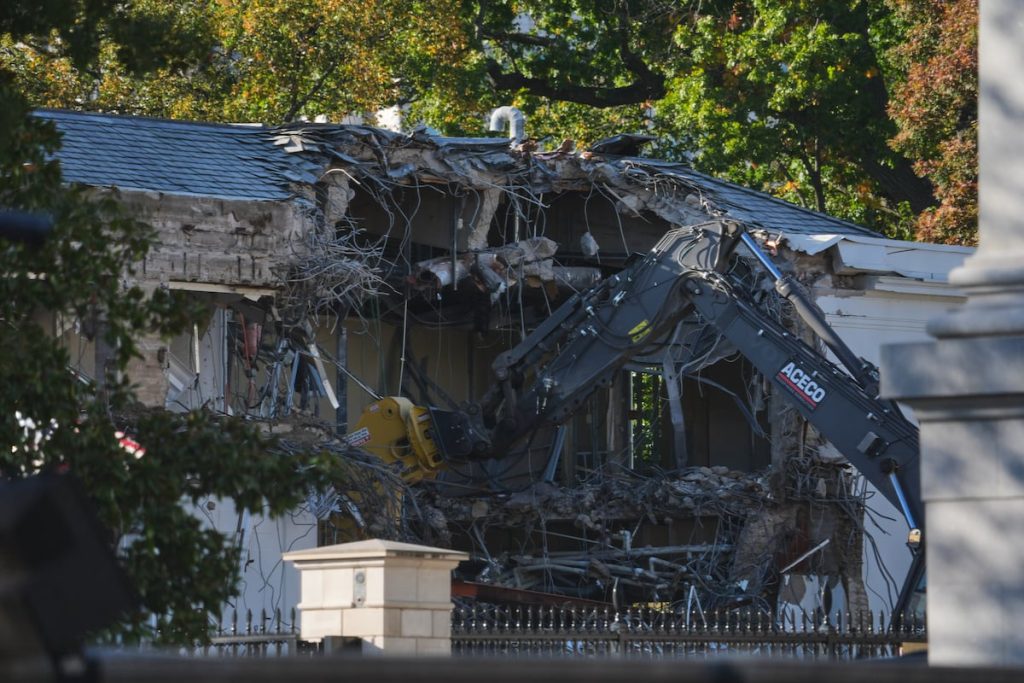President Donald Trump on Monday acknowledged his project to demolish the White House East Wing to add a $250 million, 90,000-square-foot ballroom.
The building’s many reconstruction and remodeling efforts since construction began in 1792 have drawn media, congressional and public ire.
This one has been no different.
Trump’s mention of the project, on the day the demolition began, came at an event honoring the Louisiana State University and Louisiana State University at Shreveport baseball teams.
“Right on the other side, you have a lot of construction going on, which you might hear periodically,” Trump said.
The long-touted project was addressed by White House press secretary Karoline Leavitt in July, with Leavitt saying the “state ballroom” would occupy space now occupied by the current White House East Wing.
“For more than 150 years, every President has dreamt about having a Ballroom at the White House to accommodate people for grand parties, State Visits, etc.,” the president wrote on his Truth Social platform.
“I am pleased to announce that ground has been broken on the White House grounds to build the new, big, beautiful White House Ballroom.
“Completely separate from the White House itself, the East Wing is being fully modernized as part of this process, and will be more beautiful than ever when it is complete!”
Originally constructed in 1902 by President Theodore Roosevelt, the structure that would come to be known as the East Wing was fully constructed under the administration of Roosevelt’s distant cousin and the 32nd U.S. president, Franklin D. Roosevelt.
After the U.S. entered World War II, Roosevelt, seeing the need to house additional staff and offices to reflect the growing complexity of the federal government at the time, oversaw the addition of the East Wing in 1942, according to the White House.
The two-story structure was built atop the Presidential Emergency Operations Center, or PEOC, a secure bunker that was built by FDR to serve as a secure meeting place in the event of an emergency.
“While the exact specification of this underground presidential bunker is classified,” according to the White House, “it was originally built to withstand a direct nuclear hit. Access to the PEOC is by an elevator located behind multiple vault-type doors with biometric access control systems.”
The project, however, was not without its critics.
The construction of the wing was highly controversial during the war, with congressional Republicans labeling the expenditure as wasteful, while others accused Roosevelt of using the project to bolster his own image.
First lady Eleanor Roosevelt maintained the first social secretary for a first lady in the East Wing, and with the conclusion of the war, the East Wing evolved into the space where first ladies maintained offices. First ladies have kept their own offices there, starting with President Jimmy Carter’s wife, Rosalynn Carter.
Designated a historic site by Congress in 1961, the National Park Service oversees care of the White House and its grounds. The agency decreed in September 2014 that it would work with presidential administrations, the Secret Service and other agencies “to ensure both the preservation and use of one of the most recognized houses in the world.”
The White House, the Supreme Court building, the Capitol and all their “related buildings and grounds” are exempt from the National Historic Preservation Act of 1966, which requires federal agencies “initiate measures necessary to direct their policies, plans and programs in such a way that federally owned sites … are preserved, restored and maintained for the inspiration and benefit of the people.” Consultations to change such properties or grounds under the act require a formal review process. The White House does not have such limitations.
Instead, the White House has its own committee, The Committee for the Preservation of the White House, which is chaired by the director of Park Service and made up of federal officials and members appointed by the president.
Last week, during a dinner with tech, finance and defense industry executives, Trump relayed to the audience that he was told that there were “zero zoning conditions” set for the project.
“I said, ‘How long will it take me?’” Trump said.
“‘Sir, you can start tonight, you have no approvals.’ I said, ‘You gotta be kidding.’ They said, ‘Sir, this is the White House, you’re the president of the United States, you can do anything you want.’”
Despite this, there is growing outrage over the project with the Society of Architectural Historians releasing a statement urging Trump to work with historians and architects alike, writing:
“While we recognize that the White House is a building with evolving needs, and that it has undergone various exterior and interior modifications since construction began in 1792,” the society wrote, “the proposed ballroom will be the first major change to its exterior appearance in the last 83 years (since the East Wing in its current form was built in 1942).
“Therefore, such a significant change to a historic building of this import should follow a rigorous and deliberate design and review process.”
Claire Barrett is the Strategic Operations Editor for Sightline Media and a World War II researcher with an unparalleled affinity for Sir Winston Churchill and Michigan football.
Read the full article here


